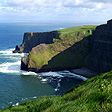GLENDALOUGH – VALLEY
OF TWO LAKES
Monastic Ruins of Wicklow Mountains
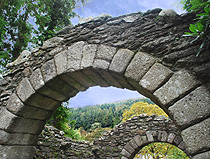 Crossing through the
great stone arch you enter another world. Glendalough, long recognized
as one of Ireland’s great monastic sites of the
early middle ages. With its name derived from the Gaelic meaning the
Valley of Two Lakes, where the confluence of two streams joined was the
spot in the beautiful glens of modern Wicklow where the son of a noble
family from Leinster founded his church. There is no clear date of St
Kevin’s arrival at Glendalough in the 6th Century, but the legend
tells that as the younger son of the family, with no chance of inheriting
lands and titles, like many second sons, chose religion as his refuge.
He studied as a child in the care of three monks and wandered into the
wilderness. It is told
in early legends that Kevin lived in the hollow of a tree in the valley,
so taken with its spiritual nature, he returned
later with a small following of monks to establish a monastery. His
fame spread among the people of the area and his settlement grew to
fill the
valley. St Kevin died about 618, but his monastery flourished with
a series of abbots to follow, and raids recorded in the Irish historical
annals.
Crossing through the
great stone arch you enter another world. Glendalough, long recognized
as one of Ireland’s great monastic sites of the
early middle ages. With its name derived from the Gaelic meaning the
Valley of Two Lakes, where the confluence of two streams joined was the
spot in the beautiful glens of modern Wicklow where the son of a noble
family from Leinster founded his church. There is no clear date of St
Kevin’s arrival at Glendalough in the 6th Century, but the legend
tells that as the younger son of the family, with no chance of inheriting
lands and titles, like many second sons, chose religion as his refuge.
He studied as a child in the care of three monks and wandered into the
wilderness. It is told
in early legends that Kevin lived in the hollow of a tree in the valley,
so taken with its spiritual nature, he returned
later with a small following of monks to establish a monastery. His
fame spread among the people of the area and his settlement grew to
fill the
valley. St Kevin died about 618, but his monastery flourished with
a series of abbots to follow, and raids recorded in the Irish historical
annals.
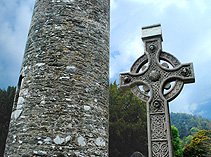 Glendalough
reached its height in the 12th Century when it was designated as one
of the
two diocese of North Leinster in the Synod of Rath Breasail
in 1111, and the rising of its Abbot, Laurence O’Toole to Archbishop
of Dublin in 1162. Glendalough continued for another hundred years as
a thriving settlement until routed and destroyed in 1398 by the English
troops of Richard II, during his personal campaign to subdue the Irish
clans under Art McMurrough, (MacMurchadha), the King of Leinster. The
two had attempted a mediation in the valleys of Wicklow near Avoca (see Avoca
Weaving Mill), but upon its failure, the last of the Plantagenet
kings marched toward Dublin
reeking
havoc on all in his path. Through the next centuries the enclave of Glendalough
remained as a local church, a place of pilgrimmage and mostly a graveyard,
with crosses and markers through the centuries scattered throughout.
Glendalough
reached its height in the 12th Century when it was designated as one
of the
two diocese of North Leinster in the Synod of Rath Breasail
in 1111, and the rising of its Abbot, Laurence O’Toole to Archbishop
of Dublin in 1162. Glendalough continued for another hundred years as
a thriving settlement until routed and destroyed in 1398 by the English
troops of Richard II, during his personal campaign to subdue the Irish
clans under Art McMurrough, (MacMurchadha), the King of Leinster. The
two had attempted a mediation in the valleys of Wicklow near Avoca (see Avoca
Weaving Mill), but upon its failure, the last of the Plantagenet
kings marched toward Dublin
reeking
havoc on all in his path. Through the next centuries the enclave of Glendalough
remained as a local church, a place of pilgrimmage and mostly a graveyard,
with crosses and markers through the centuries scattered throughout.
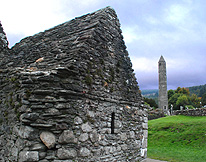 The site of Glendalough
features a number of remaining buildings, mostly dating from the 10th
and 12th Centuries. What is most striking about
them and why they survived is the stolid stone construction, even the
roofs made of stone, resisting the pull of gravity, though some were
reconstructed in the 1800’s. The Gateway is one of the most important
monuments, the only one of its kind remaining in Ireland, fine granite
arches with a cross engraved stone denoting the confines of the enclave
as a place of sanctuary. The Round Tower, one a several still existing
in the area (see St Declan’s Well), used as a
watch tower and place of refuge during attack, originally with six wooden
floors connected
by ladders (see Round Towers Vikings). St. Kevin’s Church,
The site of Glendalough
features a number of remaining buildings, mostly dating from the 10th
and 12th Centuries. What is most striking about
them and why they survived is the stolid stone construction, even the
roofs made of stone, resisting the pull of gravity, though some were
reconstructed in the 1800’s. The Gateway is one of the most important
monuments, the only one of its kind remaining in Ireland, fine granite
arches with a cross engraved stone denoting the confines of the enclave
as a place of sanctuary. The Round Tower, one a several still existing
in the area (see St Declan’s Well), used as a
watch tower and place of refuge during attack, originally with six wooden
floors connected
by ladders (see Round Towers Vikings). St. Kevin’s Church,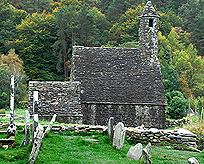 also called “The Kitchen” is
a complete building of stone, with a conical belfry. The largest structure
at Glendalough is the cathedral, with partial walls remaining and just
a few yards from its southern end, St Kevin’s Cross. Other buildings
require a hike to the lakes, including the tiny church known as “St
Kevin’s Bed” accessible only by boat in the middle of the
upper lake. The beautiful hills around Glendalough offer several hiking
trails for exploring the Wicklow Mountains National Park. Trail maps
are available at the park information office at Upper Lake.
also called “The Kitchen” is
a complete building of stone, with a conical belfry. The largest structure
at Glendalough is the cathedral, with partial walls remaining and just
a few yards from its southern end, St Kevin’s Cross. Other buildings
require a hike to the lakes, including the tiny church known as “St
Kevin’s Bed” accessible only by boat in the middle of the
upper lake. The beautiful hills around Glendalough offer several hiking
trails for exploring the Wicklow Mountains National Park. Trail maps
are available at the park information office at Upper Lake.
Visiting Glendalough
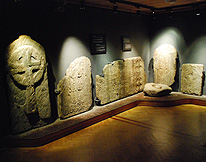 The entrance to the
Glendalough ruins is free, but the modern visitor’s
center has several exhibits explaining the history of the site, with
a model of how it once existed as a thriving society, and a collection
of remarkable early carved stone Celtic Cross markers, along with "Bullaun
Stones" - used for grinding and work in the Iron Age. Interactive
displays and a 17 minute audio-visual presentation "Ireland of the
Monasateries" tells the monastic history of sites like Glendalough.
The Visitor’s Center is open from Mid-March to Mid-October. Entrance
is €3 for adults, €2 for seniors and €1 for children and
students.
The entrance to the
Glendalough ruins is free, but the modern visitor’s
center has several exhibits explaining the history of the site, with
a model of how it once existed as a thriving society, and a collection
of remarkable early carved stone Celtic Cross markers, along with "Bullaun
Stones" - used for grinding and work in the Iron Age. Interactive
displays and a 17 minute audio-visual presentation "Ireland of the
Monasateries" tells the monastic history of sites like Glendalough.
The Visitor’s Center is open from Mid-March to Mid-October. Entrance
is €3 for adults, €2 for seniors and €1 for children and
students.
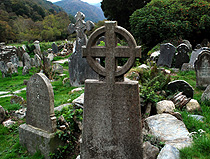 Glendalough has been
a tourist site since the 1700s and somewhat incongruous with the solemnity
of the monastic ruins are the modern commerce of souvenir
and snack stands set up just outside the sanctuary of the entrance arch.
The Glendalough
Hotel is directly next to the ruins site and a number
of other bed & breakfast type lodgings are nearby. Glendalough is
best reached by car. A bus runs from Wicklow with St Kevin’s Bus
service and regular day coach tours are available from Dublin through
Bus Éireann and other companies. © Bargain
Travel Europe
Glendalough has been
a tourist site since the 1700s and somewhat incongruous with the solemnity
of the monastic ruins are the modern commerce of souvenir
and snack stands set up just outside the sanctuary of the entrance arch.
The Glendalough
Hotel is directly next to the ruins site and a number
of other bed & breakfast type lodgings are nearby. Glendalough is
best reached by car. A bus runs from Wicklow with St Kevin’s Bus
service and regular day coach tours are available from Dublin through
Bus Éireann and other companies. © Bargain
Travel Europe
Compare best hotel deals in County Wicklow on TripAdvisor
Web
Info
Heritage
Ireland
These articles are copyrighted and the sole property of Bargain Travel Europe and WLPV, LLC. and may not be copied or reprinted without permission.
SEE ALSO:
ST AUDOEN’S NORMAN CHURCH - DUBLIN

